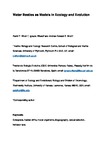Water beetles as models in ecology and evolution
| dc.contributor.author | Bilton, David | |
| dc.contributor.author | Ribera, I | |
| dc.contributor.author | Short, AEZ | |
| dc.date.accessioned | 2019-01-15T10:06:01Z | |
| dc.date.issued | 2019-01-12 | |
| dc.identifier.issn | 0066-4170 | |
| dc.identifier.issn | 1545-4487 | |
| dc.identifier.uri | http://hdl.handle.net/10026.1/13137 | |
| dc.description | Embargo date changed from 12.01.2021 to tomorrow as there is no embargo stated in SHERPA/RoMEO. SR 14.02.19 | |
| dc.description.abstract |
<jats:p>Beetles have colonized water many times during their history, with some of these events involving extensive evolutionary radiations and multiple transitions between land and water. With over 13,000 described species, they are one of the most diverse macroinvertebrate groups in most nonmarine aquatic habitats and occur on all continents except Antarctica. A combination of wide geographical and ecological range and relatively accessible taxonomy makes these insects an excellent model system for addressing a variety of questions in ecology and evolution. Work on water beetles has recently made important contributions to fields as diverse as DNA taxonomy, macroecology, historical biogeography, sexual selection, and conservation biology, as well as predicting organismal responses to global change. Aquatic beetles have some of the best resolved phylogenies of any comparably diverse insect group, and this, coupled with recent advances in taxonomic and ecological knowledge, is likely to drive an expansion of studies in the future.</jats:p> | |
| dc.format.extent | 359-377 | |
| dc.format.medium | ||
| dc.language | en | |
| dc.language.iso | en | |
| dc.publisher | Annual Reviews | |
| dc.subject | Coleoptera | |
| dc.subject | habitat shifts | |
| dc.subject | model organisms | |
| dc.subject | biogeography | |
| dc.subject | sexual selection | |
| dc.subject | indicator taxa | |
| dc.title | Water beetles as models in ecology and evolution | |
| dc.type | journal-article | |
| dc.type | Journal Article | |
| dc.type | Research Support, Non-U.S. Gov't | |
| dc.type | Review | |
| plymouth.author-url | https://www.webofscience.com/api/gateway?GWVersion=2&SrcApp=PARTNER_APP&SrcAuth=LinksAMR&KeyUT=WOS:000456391400020&DestLinkType=FullRecord&DestApp=ALL_WOS&UsrCustomerID=11bb513d99f797142bcfeffcc58ea008 | |
| plymouth.issue | 1 | |
| plymouth.volume | 64 | |
| plymouth.publication-status | Published | |
| plymouth.journal | Annual Review of Entomology | |
| dc.identifier.doi | 10.1146/annurev-ento-011118-111829 | |
| plymouth.organisational-group | /Plymouth | |
| plymouth.organisational-group | /Plymouth/Faculty of Science and Engineering | |
| plymouth.organisational-group | /Plymouth/Faculty of Science and Engineering/School of Biological and Marine Sciences | |
| plymouth.organisational-group | /Plymouth/REF 2021 Researchers by UoA | |
| plymouth.organisational-group | /Plymouth/REF 2021 Researchers by UoA/UoA07 Earth Systems and Environmental Sciences | |
| plymouth.organisational-group | /Plymouth/Research Groups | |
| plymouth.organisational-group | /Plymouth/Research Groups/Marine Institute | |
| plymouth.organisational-group | /Plymouth/Users by role | |
| plymouth.organisational-group | /Plymouth/Users by role/Academics | |
| dc.publisher.place | United States | |
| dcterms.dateAccepted | 2018-11-01 | |
| dc.rights.embargodate | 2019-2-15 | |
| dc.identifier.eissn | 1545-4487 | |
| dc.rights.embargoperiod | Not known | |
| rioxxterms.versionofrecord | 10.1146/annurev-ento-011118-111829 | |
| rioxxterms.licenseref.uri | http://www.rioxx.net/licenses/all-rights-reserved | |
| rioxxterms.licenseref.startdate | 2019-01-12 | |
| rioxxterms.type | Journal Article/Review |


